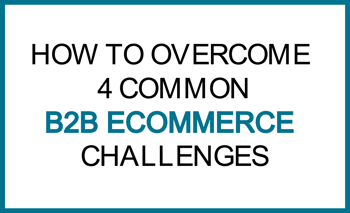
 Over the years, we’ve been champions for bringing B2C eCommerce functionality to the B2B space. But taking your B2B organization online can be a challenge. Through all of the different B2B eCommerce projects we’ve worked on, no matter the industry or company goals, we’ve seen the same four challenges over and over: creating support for the project, managing catalog content, integrating the eCommerce and ERP systems, and engaging the sales team.
Over the years, we’ve been champions for bringing B2C eCommerce functionality to the B2B space. But taking your B2B organization online can be a challenge. Through all of the different B2B eCommerce projects we’ve worked on, no matter the industry or company goals, we’ve seen the same four challenges over and over: creating support for the project, managing catalog content, integrating the eCommerce and ERP systems, and engaging the sales team.
A B2B eCommerce project can be one of the most challenging initiatives your organization takes on. It requires help from team members who have additional daily responsibilities, and it introduces an entirely new sales channel to your organization, changing the dynamic of your business model. In order for your B2B eCommerce platform to meet its potential, you need to first create support within your organization.
It’s important to ask a few key questions up front:
First, what is the site intended to do? Is it intended primarily to increase revenue, decrease costs, or improve customer satisfaction? These should be ranked in order of importance, with only one of these ranked as number one.
Does it align with the company mission and vision statements? Without that alignment, the project will not receive the support of the executive team, or anybody else in for that matter.
Can you measure the success? A B2B eCommerce site needs to have clearly defined measurements of success. This allows the project team to have explicit targets, allowing them to evaluate options and make decisions along the way.
Prior proper planning allows everyone within the company to understand the scope of the project, when each milestone will be completed, and most importantly why the project is being done in the first place. This sets a foundation and creates alignment within the company, so that everybody is working towards a common goal.
B2B eCommerce projects touch almost every part of the organization: sales and marketing, operations, finance, and especially IT. There must be a champion for the B2B site; naming an eCommerce director will help to drive the project through to launch. Also, this key leader will ensure that the site is nurtured and continues to grow once it has been launched.
The B2B eCommerce Director should know conventional sales strategies, as well as how to harness the power of the internet and social marketing strategies in a B2B environment. This person should be an effective leader and have the ability to create alliances with other departments within the organization.
During the implementation project, and especially after the launch, the project team will need support from marketing, sales, finance, operations, and most heavily from IT. This person should be a savvy negotiator to garner support from the other departments, ensuring the success of the initial project and entire B2B initiative.
An eCommerce site requires an incredible amount of data in order to provide customers with the information they need to make a sale. From short and extended product descriptions and item dimensions and attributes, to related items and high-quality product images, that’s a lot of content to keep organized. To prevent an immediate blowup as you’re implementing your B2B eCommerce site, first collect and organize all of your necessary data.
ECommerce systems have a voracious appetite for content, and most organizations are not prepared, initially, to feed this beast. There are some key pieces of data that should be passed to the eCommerce system, including:
Whether it’s marketing copy featuring well-written, descriptive content, or product specifications which have been garnered from the manufacturer or engineer, this data resides somewhere within your organization. The real trick is finding that data and accessing it.
Often, much of this product data can be found within the ERP. Typically, this data will need to be augmented once it has been entered into the eCommerce engine.
Catalog data can also be acquired from the vendor that supplies these items. Often, the vendor has rich content and high quality images available.
Another viable option is your point of sale system. These systems store data about your products, and are specifically geared to simplifying the sales process for your customers, so there should be good content and images there.
Once all the catalog data is found and organized, a strategy needs to be devised to get the catalog loaded into the eCommerce system. We believe that the best strategy is to set up an integration between your eCommerce system and your ERP.
A B2B eCommerce and ERP integration can be a daunting task. In fact, it can be so intimidating for some companies that they forego it all together and instead duplicate the ERP data and business logic into the eCommerce system. Keeping the two systems decoupled like this can lead to a whole host of problems, and integrating your systems is almost always the better solution. We’ve outlined our golden rules of integration to make the processes easier.
Data is the lifeblood of an eCommerce engine, and the data needed typically already exists in the ERP. This makes it critical to set a strategy around the data integration. It is crucial to determine where each data element should be stored, and which system “owns” the data. Careful consideration should be given to data points such as Customer Master data, Item/Catalog data, and Customer Order Information.
After it is decided where each data point should reside, who owns it and how it will be shared, a data map should be created so that ownership is clearly defined and documented. A great mantra to keep in mind is: “There can only be one source of the truth”; this will help to establish whether the eCommerce or ERP system should own the data.
After it’s determined whether the eCommerce or ERP system owns each piece of data, consider the business logic required to process an order. ECommerce systems typically include functionality that is duplicated in the ERP, such as item pricing, taxing, and order processing. In considering these redundancies, look to keep a business function within the system that is best suited for processing that function.
A great example is the pricing engine. Most robust ERP and eCommerce systems alike have very flexible pricing engines. However, the eCommerce system will typically feature powerful promotion and discount modules as well. Duplicating the ERP pricing engine into the eCommerce system can be a daunting task, and generally is not recommended. The project team must look at the business logic, and determine which system handles the functionality best.
There are a host of integration methodologies and tools available for linking ERP systems to eCommerce engines. A small sample of tools companies may consider includes FTP processes, IBM MQ Series, Web Services, Microsoft BizTalk and Oracle Fusion.
It’s often beneficial to use the integration tools that are already used within the organization. This creates consistency across all projects, and allows the development team to better understand and support the new integration points. It is also beneficial to leverage existing integration processes and methodologies. This helps to keep the projects costs down, as the existing integration assets can be reused, reducing development time and costs.
Any B2B organization implementing an eCommerce site and forgets their sales personnel is asking for trouble. It’s common for sales staff to view the eCommerce site as a replacement for all of their hard work, and they are likely to be resistant to this new tool. But by engaging your sales team, getting their input, and defining the benefits of the new system, you can move forward as a united front.
Your organization should consider up front whether or not to pay sales commissions on orders that are entered through the eCommerce system.
It’s understood in the industry that the costs of processing orders through an eCommerce channel are lower than orders processed through other methods (telephone, email, fax, etc). Because of this, the gross margin on eCommerce orders is greater than traditional orders. Therefore, a strong case can be made that the sales team should be commissioned on these orders. By paying the sales team commission for these eCommerce orders, your company ensures that the sales team embraces the eCommerce system and drives the customers to utilize it. This will help to drive down the cost of transactions and ensure the success of the project.
A fully integrated B2B eCommerce site brings with it several new tools and strategies that can improve the lives of the sales team. Essentially, the eCommerce system can be leveraged as the Sales Force Automation (SFA) tool.
One if the most positive aspects of this is the introduction of customer self-service tools. Various industry studies have found that roughly 45% of customer calls into an organization (and the sales team) center around three questions: What is my price for an item, is the item in stock and where is my order? By tightly integrating the eCommerce system to the ERP, these three questions can be answered for the customer without involving any person within the company.
It may sound like we've made the process simple by breaking it down like this, but executing a successful B2B eCommerce strategy can be a complicated task. If you're ready to take on the challenge, you'll need a team behind you. Contact our certified Magento team to get started.
Lorem ipsum dolor sit amet, consectetur adipiscing elit

For the past two decades, we've made it our business to help you work smarter. From commerce challenges to ERP customizations, we support the power of your big ideas by helping you work more strategically, more intuitively, and more efficiently.
2658 Scranton Road, Suite 3
Cleveland, Ohio 44113
216.369.3600
No Comments Yet
Let us know what you think